Mint Plant Care: How to Grow This Refreshing Herb Indoors and Out
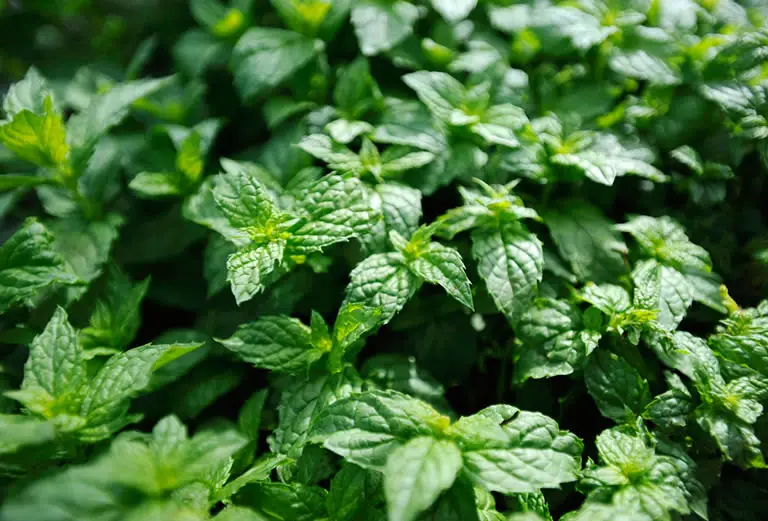
Mint (Mentha spp.) is one of the most widely grown and useful herbs around the world—loved for its clean, cooling flavor and lush, spreading habit. Whether you’re brewing tea, flavoring recipes, or just enjoying the fresh scent on your windowsill, mint is a vigorous grower that’s easy to care for once you understand its preferences.
Fast-growing and low-maintenance, mint thrives in both containers and garden beds. With a little control, this herb can become a constant source of fresh, aromatic leaves all year long.
Here’s how to grow mint successfully indoors, outdoors, or wherever you need a little green refreshment.
Table of Contents
- What Makes Mint Special
- Light Requirements: Bright, Filtered Light Is Best
- Watering: Keep Soil Lightly Moist
- Soil and Potting: Rich and Moisture-Retentive
- Fertilizer: Feed Gently Through the Growing Season
- Pruning and Maintenance: Keeps It Bushy and Flavorful
- Best Spot in the Home
- Outdoor Mint Care
- Popular Mint Varieties
- Common Problems and Fixes
- Final Thoughts
What Makes Mint Special
Mint is a perennial herb native to Europe, Asia, and parts of North Africa.
It grows naturally along riverbanks and in moist meadows, which makes it unusually tolerant of damp soil and lower light conditions compared to most other herbs.
There are dozens of mint species and hybrids, including peppermint, spearmint, apple mint, chocolate mint, and more.
Each has a slightly different scent and flavor, but all share the same rapid growth and spreading roots.
Because of its vigorous underground runners, mint is best grown in containers to keep it from taking over your garden.
Light Requirements: Bright, Filtered Light Is Best
Mint prefers bright, indirect light or partial sun.
Outdoors, it grows well in morning sun with afternoon shade, especially in hot climates.
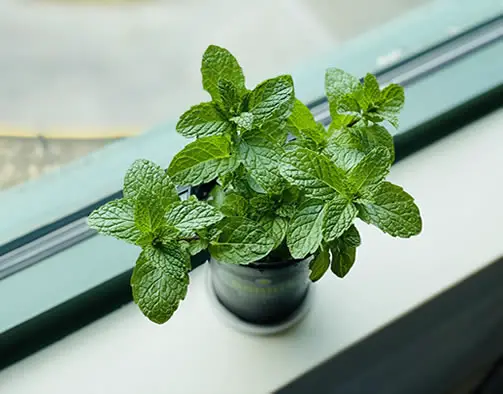
Indoors, place your mint near a south- or east-facing window where it can receive 4–6 hours of light per day.
If it starts getting leggy or losing its flavor, move it to a brighter location or add a grow light.
Mint tolerates a bit less light than other herbs, which makes it a great choice for kitchens and shaded patios.
Watering: Keep Soil Lightly Moist
Unlike many herbs, mint enjoys consistently moist soil.
Water when the top inch of soil feels dry, and aim to keep the soil lightly damp—not soggy or bone-dry.
Outdoors, mint benefits from regular watering during hot weather or dry spells.
Indoors, check the soil every few days and adjust based on air temperature and humidity.
Mint wilts quickly when thirsty, but it usually bounces back after a thorough drink.
Soil and Potting: Rich and Moisture-Retentive
Mint grows best in loamy, well-draining soil that retains some moisture but doesn’t stay waterlogged.
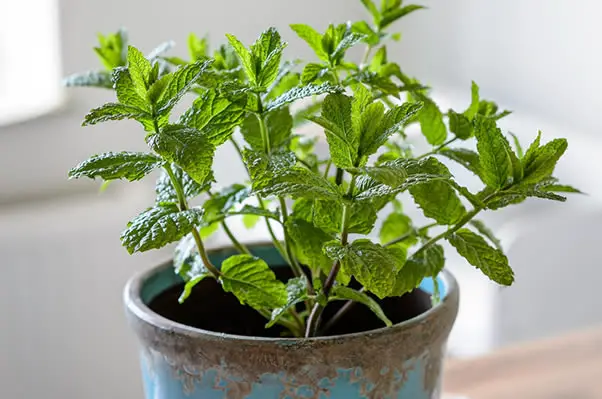
For container growing, use a mix of:
-
2 parts potting soil
-
1 part compost or worm castings
-
1 part perlite or coarse sand
Outdoors, plant in garden beds amended with compost or organic matter.
If your soil is heavy clay, improve drainage with sand or plant mint in raised beds or containers.
Mint thrives in slightly acidic to neutral soil with a pH between 6.0 and 7.0.
Fertilizer: Feed Gently Through the Growing Season
Mint is a fast-growing herb and benefits from light feeding during spring and summer.
Use a balanced, organic fertilizer every 4–6 weeks, such as a 5-5-5 formula like this one or 10-10-10 like this one.
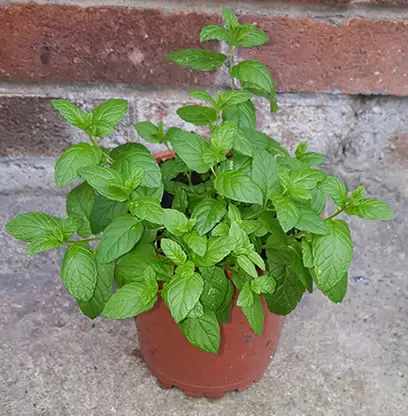
Too much fertilizer can lead to excessive leaf growth with less flavor.
Dilute your fertilizer to half strength and avoid feeding in winter when the plant is dormant.
Liquid seaweed, fish emulsion, or compost tea are excellent gentle options for mint.
Pruning and Maintenance: Keeps It Bushy and Flavorful
Frequent pruning encourages bushier growth and keeps your mint plant from becoming leggy.
-
Pinch or snip back stems regularly to encourage branching.
-
Harvest the top few inches of new growth to promote fuller shape.
-
Remove any flowers to extend the plant’s productive season and preserve flavor.
If the plant becomes too woody or overgrown, cut it back by about one-third in early spring or after flowering.
In containers, trim runners that spill too far over the edge or replant divisions in fresh soil.
Consider using healthy cuttings for propagating new herb plants as outlined in our article Mint Propagation: 4 Simple Ways to Grow Endless Fresh Leaves.
Best Spot in the Home
Mint is perfect for kitchen windowsills, bright bathrooms, or sunrooms where it can get good light and easy access to water.
Because of its clean scent and culinary use, it’s one of the best herbs to keep near food prep areas.
You can also place a pot on your balcony, porch, or part-shaded patio during the warmer months.
Outdoor Mint Care
In USDA zones 3–11, mint grows vigorously outdoors during the growing season.
It’s winter-hardy in many regions and will return each spring from its underground roots.
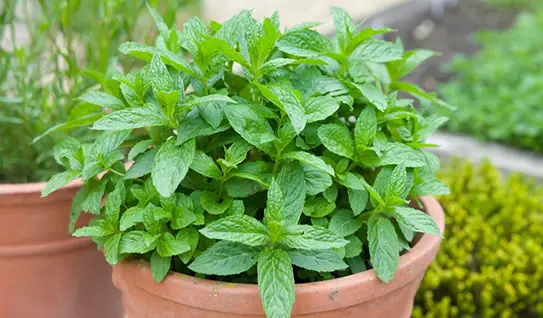
-
Plant in partial sun, especially in hot climates.
-
Use containers or root barriers to keep it from spreading too aggressively.
-
Water regularly to keep the soil lightly moist.
-
Mulch with compost or shredded leaves to retain moisture and improve soil structure.
In very cold zones, mulch heavily over the root zone in late fall to protect the plant through winter.
You can also dig up and pot a section of mint in autumn to overwinter indoors on a sunny windowsill.
Popular Mint Varieties
There are dozens of mint cultivars with different flavors, colors, and growth habits. Here are a few top picks:
Spearmint (Mentha spicata) – Classic, sweet mint with smooth green leaves. Best for mojitos, teas, and salads.
Peppermint (Mentha × piperita) – Strong, cooling flavor with darker leaves and a slightly spicy edge. Great for desserts and tea.
Apple Mint (Mentha suaveolens) – Fuzzy, rounder leaves with a fruity aroma. Slower-growing and ornamental.
Chocolate Mint – A variety of peppermint with a subtle chocolate scent. Beautiful dark stems and a favorite for dessert recipes.
Lemon Mint – Delivers a zesty lemon note. Popular for teas and summer drinks.
Pineapple Mint – Variegated foliage with creamy white edges and a sweet, tropical scent. Great for ornamental planting and flavor.
All mint types propagate easily from stem cuttings or division, making it easy to grow your favorites year after year.
Common Problems and Fixes
Yellow leaves
Often caused by overwatering or poor drainage.
Let soil dry slightly and improve airflow.
Brown leaf edges
Usually due to underwatering or low humidity indoors.
Water more frequently and mist occasionally.
Aphids or spider mites
Hose off the plant outdoors or wipe leaves with a mild soap and water solution.
Powdery mildew
Appears in humid, still conditions.
Thin out stems to increase airflow and avoid watering from above.
Leggy stems
Caused by low light or infrequent pruning.
Move to a brighter location and trim back to shape.
Final Thoughts
Mint is one of the most beginner-friendly herbs you can grow—and one of the most rewarding.
With its fast growth, versatile flavors, and fresh fragrance, it’s a must-have in any kitchen, garden, or patio setup.
Just give it good light, moist soil, and regular pruning, and it will keep giving you sprigs of refreshing green all season long.
Thanks for reading! I'm Michael — houseplant fanatic and your Pinterest plant guide.
Follow me on Pinterest for fresh updates 🌿



